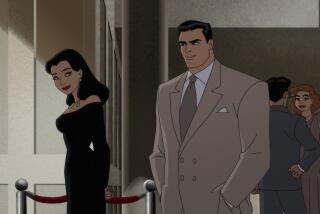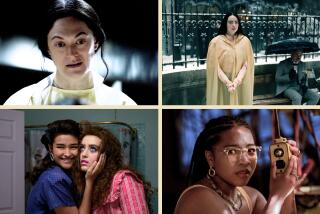Keeping Wonder Woman in Shape
- Share via
NEW YORK — Is it the star-spangled panties?
Maybe. Let’s just think about the star-spangled panties for a while.
There. OK.
Something happens when you look at her now, reminding you of what she used to be. (And what you used to be.) It presses several buttons in the tangled subconscious: America, patriotism, but also ancient Greece, the gods, democratic ideals. Warrior women shaving their armpits and legs. Quiet women wearing librarian specs, who duck into closets and become something else.
When it comes to deconstructing Wonder Woman, how much of the day can anyone (should anyone) spend thinking only about her power cleavage, or being helpless in the cinch of her kinky golden lasso? Where else to begin?
With a pencil.
First, he sketches her face, then neck, bare shoulders. He then moves down to the double-W’s emblazoned across her thrust-out chest.
For reference, Phil Jimenez keeps handy a three-ring binder of pages clipped from lingerie catalogues and lady bodybuilder magazines. As the current illustrator and co-writer of DC Comics’ monthly Wonder Woman comic book, Jimenez understands that his heroine is ultimately about much more than her bust.
“Sometimes you can’t relate to her,” he says. “Wonder Woman has no problems and who can relate to that?”
She does have one problem: Most of the world has forgotten about her. Sixty years ago, she stirred imaginations and helped vanquish Hitler. This month in the trade magazine Wizard, WW ranks 86th on a list of the 100 top-selling comic books.
Still, we’d know her if we saw her. This is what happens to spent icons. They become easily recognizable Halloween costumes with no context, aging reference points to outdated ideas that may have once been a metaphor for something--which was what, in her case? Feminism? Love? Sacrifice? Try this: The man who invented Wonder Woman, a psychologist, wanted little boys to access the female archetype within themselves.
“She’s a very difficult character to write, so people have tended to write around her instead,” Jimenez says. “For a lot of people, she winds up being about the costume.”
Growing up, Jimenez loved Wonder Woman. After high school in Orange County, he set out for New York in the early ‘90s to draw professionally.
Last fall, Jimenez, 30, was assigned his dream job: the care and feeding of Wonder Woman. Coincidentally or otherwise, the more reverent of WW’s stewards and loyal fans tend to be gay men. Many female artists have steered clear of the assignment; straight men, agog, transformed her into “a Terminator babe,” he says. “Which is so not like her.”
Jimenez works at the drafting table in his tidy apartment in Manhattan’s Upper West Side. Bound editions of his favorite comics line the bookshelves; old WW toys and gewgaws line the windowsill.
Comic book artists tend to occupy themselves with background, much of which the reader never sees. They fantasize about the contents of superheroes’ refrigerators, their laundry routines. Jimenez wonders:
Should she wear a Chanel suit to a U.N. fund-raiser?
If she moves to New York, should she get a penthouse on the East Side or West Side?
WW fans tend to be adult, generally male, though the female segment is vocal. A large contingent are gay men, some lesbians; Jimenez, who chats with fans on a Web site, says he was most surprised at the number of black male fans.
Amazon Princess Is Psychologist’s Creation
In 1941 William Moulton Marston, a Harvard-educated psychologist secretly writing comic books on the side, gave WW to the world. In “Wonder Woman: The Complete History” (Chronicle Books), historian Les Daniels paints Marston as one of those deeply complex men who are in their own way genius, and perhaps just a bit nutty professor. At Harvard, he pioneered research that led to the polygraph.
An outspoken publicity hound, Marston wound up consulting Hollywood producers in the early ‘30s. He tested moviegoers’ response to colors and sound effects. He also wrote randy pulp novels about Greco-Roman mythology and history.
Marston fathered two children with his wife, and two children with his research assistant. He became something of a feminist, telling the New York Times in 1937 that America would become a matriarchy within 100 years.
At some point, everything in Marston’s world merged into the making of a modern goddess. This landed him in his own fantasy: Amazonia.
Under the pen name Charles Moulton, he created Wonder Woman, curvily drawn by Harry Peter in All-Star Comics No. 8, first appearing a month before the Japanese bombed Pearl Harbor. In that episode, the Amazon princess Diana rescues downed Air Force pilot Steve Trevor and is chosen to return to man’s world and fight evil.
WW struggled not to swoon over Steve, putting her mission first. After a rousing fight with negatively portrayed ethnic stereotypes, she would stand arms akimbo and preach justice to a cruel world, like an American flag with great gams.
Wonder Woman Loses Her Feminist Edge
After Marston died in 1947, the idealism began to weaken. WW constantly fretted about her secret identity (a powerful McCarthyism vibe runs through these issues) and whether she should chuck it all and marry Steve. A standard scenario had WW walking down the wedding aisle, only to be interrupted before vows by would-be world dominators. The press nicknamed her “Wonder Woman” and soon she was battling Nazi baronesses, the vainglorious Cheetah and, eventually, gooey space aliens.
In the late ‘60s, with sales of the comic book waning, Steve was assassinated and Wonder Woman lost her superpowers and ditched the star-spangled panties for mod miniskirts.
Gloria Steinem saved her that time, by putting her on the cover of the first issue of Ms., in 1972, reiterating Marston’s original pro-feminist intent. It is the 1976-79 television show--Lynda Carter in the plexiglass airplane--that so many people will forever equate with the character. But in a jumble of strong pop culture heroines--bionic women, policewomen--Wonder Woman had outlived her usefulness to the collective unconscious.
The TV show was canceled, and things got worse for the comic book. Having run for 329 consecutive issues, Wonder Woman was temporarily shelved in 1985.
This year, Jimenez hopes to deal with each of Wonder Woman’s many guises in a multi-layered story line, a discreet 60th-anniversary nod. The comic’s current version was “rebooted” in 1986.
“She has transcended 40 years of bad scripts, after all,” says DC publisher Jenette Kahn. “She’s meant a tremendous amount, especially to women. She’s the first feminist in popular fiction.”
DC, part of AOL Time Warner, is also duty-bound to Wonder Woman; she’s an important trademark to the company’s repertoire, and a perpetual agreement with Marston’s estate stipulates that a Wonder Woman comic book must be regularly published to keep the rights to the character.
Meanwhile . . . evil lurks.
Hollywood has again turned its greedy, villainous eyes toward the Amazing Amazon; Jimenez isn’t thrilled with reports of a proposed Wonder Woman movie. Early gossip had Mariah Carey starring, then Sandra Bullock, then Catherine Zeta-Jones. What he hears of it sounds campy to him, nowhere near the reverence required.
“I offered them my Wonder Woman bible,” Jimenez says, referring to the sheer tonnage of contemplation and thinking and research he’s done into this imaginary goddess, “and they said no. They didn’t want it.”
More to Read
The biggest entertainment stories
Get our big stories about Hollywood, film, television, music, arts, culture and more right in your inbox as soon as they publish.
You may occasionally receive promotional content from the Los Angeles Times.










